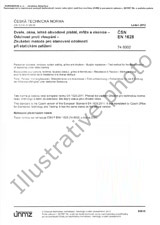We need your consent to use the individual data so that you can see information about your interests, among other things. Click "OK" to give your consent.
ČSN ETSI EN 301427-V2.1.1 (876031)
Satellite Earth Stations and Systems (SES); Harmonised Standard for low data rate Mobile satellite Earth Stations (MES) except aeronautical mobile satellite earth stations, operating in the 11/12/14 GHz frequency bands covering the essential requirements of article 3.2 of the Directive 2014/53/EU
Translate name
STANDARD published on 1.1.2017
The information about the standard:
Designation standards: ČSN ETSI EN 301427-V2.1.1
Classification mark: 876031
Catalog number: 500970
Publication date standards: 1.1.2017
SKU: NS-672490
The number of pages: 52
Approximate weight : 156 g (0.34 lbs)
Country: Czech technical standard
Category: Technical standards ČSN
The category - similar standards:
Radio relay and fixed satellite communications systemsSatellite
Annotation of standard text ČSN ETSI EN 301427-V2.1.1 (876031):
V2.1.1
The present document applies to Mobile Earth Stations (MES), except aeronautical mobile earth stations, which have the following characteristics:
- The MES are operating in one or more frequency ranges of the Fixed Satellite Service (FSS):
- - 10,70 GHz to 11,70 GHz (space to earth);
- - 12,50 GHz to 12,75 GHz (space to earth);
- - 14,00 GHz to 14,25 GHz (earth to space).
Because the transmissions from the MES to the Satellite in the 14,00 GHz to 14,25 GHz band fall under a sec-ondary allocation, the transmissions should not cause harmful interference to primary services (e.g. the Fixed Satellite Service (FSS)) and at the same time cannot claim protection from harmful interference from those ser-vices.
- The MES may be either:
- - a Land Mobile Earth Station (LMES) radio equipment; and/or
- - a Maritime Mobile Earth Station (MMES) radio equipment not providing those distress and safety functions required by the International Maritime Organization (IMO).
- - These LMESs could be either vehicle mounted or portable equipment.
- - These MMESs are installable equipment on ships.
- - The MES could consist of a number of modules including a keyboard interface to the user.
- - The MES use linear polarization.
- - The MES operate through a geostationary satellite at least 3° away from any other geostationary satellite operating in the same frequency band and covering the same area.
- - The antenna of the MES may be omnidirectional or directional with a means of tracking the satellite.
- - The MES are operating as part of a satellite network used for the distribution and/or exchange of infor-mation between users.
- - The MES are controlled and monitored by a Network Control Facility (NCF). The NCF is outside the scope of the present document.
The present document applies to the MES with its ancillary equipment and its various terrestrial ports, and when operated within the boundary limits of the operational environmental profile declared by the manufacturer.
The present document is intended to cover the provisions of Directive 2014/53/EU [3] (RE Directive) article 3.2, which states that ". radio equipment shall be so constructed that it both effectively uses and supports the effi-cient use of radio spectrum in order to avoid harmful interference".
In addition to the present document, other ENs that specify technical requirements in respect of essential re-quirements under other parts of article 3 of the RE Directive [3] may apply to equipment within the scope of the present document.
NOTE: A list of such ENs is included on the ETSI web site



 Cookies
Cookies
